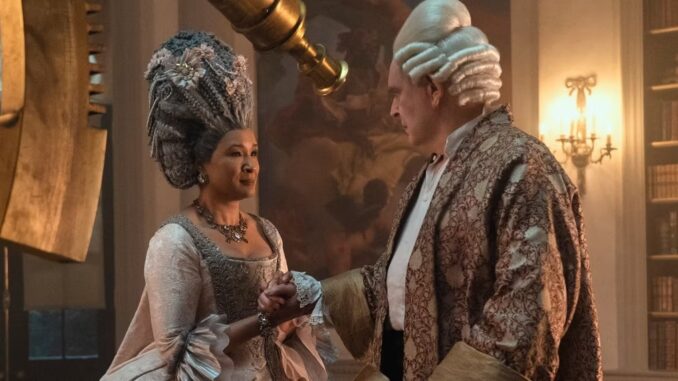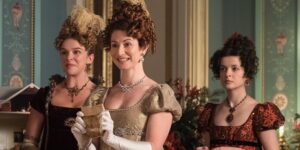
‘Queen Charlotte’ expertly blends historical stories with fictional drama, but how realistic is the show’s depiction of the queen’s many children?
Queen Charlotte: A Bridgerton Story is very much an alternative history, where real-life royals are fictionalized and embellished to create a compelling storyline. Historical figures and events have been remodeled, and this spin-off builds on Bridgerton’s appeal as a show full of romantic intrigue and high society scandal. Golda Rosheuvel reprises her role as the current Queen Charlotte, where her younger self is perfectly depicted by India Ria Amarteifio. Moving back and forth between Bridgerton’s present day and the Queen’s marital past, the show tells the story of the tumultuous early experiences of marriage between Charlotte and King George III (played by Corey Mylchreest). As in real life, the king is shown to be suffering from a steady decline in his mental stability, which has caused history to label him as a “mad king.”
This, and many other elements of the show, represent a degree of historical accuracy. One point of interest is that Queen Charlotte depicts the couple’s 15 children in the present-day scenes, where it is made clear that a succession crisis has arisen due to the absence of a legitimate heir. Factual accuracy varies when it comes to how the children of Charlotte and George III are depicted, where grains of historical have been smoothly tied into this decidedly fictional retelling. Notably, three of the couple’s 15 children died young. Two did not survive infancy, whilst their final child, Princess Amelia, succumbed to ill health at the age of 27. This is not touched upon in the show, where the focus is on the queen’s eldest and better-known offspring.
Births, Deaths & A Succession Crisis For Queen Charlotte’s Family
One of the key moments in the show’s first episode is the revelation that the queen’s grandchild and only legitimate heir has died in childbirth along with her newborn son. This is a factually accurate moment, referencing the death of Princess Charlotte of Wales, who passed away in 1817 after giving birth to a stillborn boy. She was the daughter of the queen’s oldest son, George, who would later become King George IV. This tragedy triggered a sequential crisis in the show and in real life, where the royal family was suddenly without a legitimate heir to the throne.

There was no direct heir to the throne until as late as 1819; the queen’s sons had fathered numerous offspring, but none by their wives. On the show, the queen laments that her daughters are unmarried, and her sons have only produced children out of wedlock. While it is true that her sons had many illegitimate children, it is not the case that the queen was eager for her daughters to marry. On the contrary, it was a fact that the king and queen were not keen for their daughters to find husbands. The daughters had largely secluded educations until they were presented with opportunities to find spouses. It is thought that the queen preferred to keep her children with her for their company, especially as the king’s health began to decline.
The show also implies that many of the queen’s daughters remain unmarried spinsters, but some lead just as scandalous lives as their brothers. Princess Sophia, for example, was thought to be romantically involved with the king’s chief equerry, Major-General Thomas Garth, who was more than 30 years her senior. There are even rumors that she gave birth in secret to Garth’s illegitimate child. In the TV show, the queen’s daughters lose some of their individuality for the sake of effective storytelling. Their real lives were a lot more complex than viewers have been led to believe.
‘Queen Charlotte’ Explores the Rumors, Scandals & Dozens of Illegitimate Children
The queen’s oldest son, George, became the Prince Regent in 1811 when his father’s health irretrievably worsened. He eventually became King George IV upon his father’s death in 1820. In the show, George is given a somewhat sympathetic characterization as a parent grieving for his daughter, where he is shown to absentmindedly act in accordance with the queen’s wishes. In contrast, the real George IV was generally perceived negatively by the public for his lavish spending habits and periodically extramarital relationships.
A key episode of the show features a conversation between Queen Charlotte, Lady Danbury (Adjoa Andoh), and Lady Bridgerton (Ruth Gemmell), where Charlotte laments the misfortune that her sons are in love with actresses and Catholics, and that they have numerous children by these women instead of by their wives. This is a fairly honest representation of the case where George IV was known for his affair with actress and poet, Mary Robinson, and had a long-term relationship with devout Catholic, Maria Fitzherbert.
